story and photos by Kayte Deioma
One of the “must do” activities when visiting Guadalajara, whether it’s raining or not, is a side trip to the town of Tequila to get a glimpse at how Mexico’s national beverage is produced.
The town of Tequila is located about 37 miles west of Guadalajara. Many of the 30 or so tequila distilleries in and around Tequila offer factory tours, but the granddaddy of them all, and the one with the most tour options is the José Cuervo factory right in the center of town.
The José Cuervo distillery has created a tourist experience they call Mundo Cuervo (Cuervo World). You can access as much or as little of 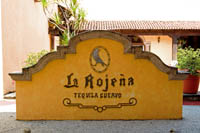 Mundo Cuervo as you have time for and fits into your budget. At the main distillery in Tequila, you can show up for a basic factory tour, which includes a tour of the distillery, La Rojeńa (named for the Cuervo son-in-law, Vincente Albino-Rojas, who acquired it as his wife’s dowry in 1812), access to the restaurant, gallery and gift shop and a margarita at the Margarita Bar. A Tasting Tour adds a sit-down tequila tasting in the Margarita Bar. A Reserva Cellar Tour adds a visit to the exclusive Reserva de la Familia (Family Reserve) aging cellar and a tasting of this premium tequila straight from the barrel under the supervision of the house tequillero. The VIP Tour is a private tour including all of the above. As of Nov 2005 prices range from 75 pesos ($7.50 US) for a basic factory tour to 250 pesos ($25 US) for a VIP Tour.
Mundo Cuervo as you have time for and fits into your budget. At the main distillery in Tequila, you can show up for a basic factory tour, which includes a tour of the distillery, La Rojeńa (named for the Cuervo son-in-law, Vincente Albino-Rojas, who acquired it as his wife’s dowry in 1812), access to the restaurant, gallery and gift shop and a margarita at the Margarita Bar. A Tasting Tour adds a sit-down tequila tasting in the Margarita Bar. A Reserva Cellar Tour adds a visit to the exclusive Reserva de la Familia (Family Reserve) aging cellar and a tasting of this premium tequila straight from the barrel under the supervision of the house tequillero. The VIP Tour is a private tour including all of the above. As of Nov 2005 prices range from 75 pesos ($7.50 US) for a basic factory tour to 250 pesos ($25 US) for a VIP Tour.
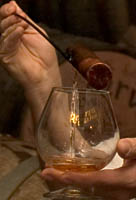 When the Spaniards colonized Mexico in the 1500s, they found the native people drinking a fermented beverage called pulque made from the heart of the maguey or agave plant. The Spaniards were running low on the spirits they had brought with them from Spain, so they distilled the pulque, creating the first mezcal wine. After a temporary ban on mezcal production in 1785, the King of Spain granted José Cuervo (Joe Crow) the first official license to produce mezcal wine in 1795. The Cuervo distillery was the first to give the name “tequila” to the type of mezcal wine produced exclusively from the heart of blue agave plants. With few exceptions, to have the designation of “tequila,” a mezcal must be produced from blue agave grown in the dry highlands of Jalisco and a few surrounding states and distilled in this same area.
When the Spaniards colonized Mexico in the 1500s, they found the native people drinking a fermented beverage called pulque made from the heart of the maguey or agave plant. The Spaniards were running low on the spirits they had brought with them from Spain, so they distilled the pulque, creating the first mezcal wine. After a temporary ban on mezcal production in 1785, the King of Spain granted José Cuervo (Joe Crow) the first official license to produce mezcal wine in 1795. The Cuervo distillery was the first to give the name “tequila” to the type of mezcal wine produced exclusively from the heart of blue agave plants. With few exceptions, to have the designation of “tequila,” a mezcal must be produced from blue agave grown in the dry highlands of Jalisco and a few surrounding states and distilled in this same area.
Mezcal (or mescal) is still the generic term for all spirits distilled from agave plants. Other mezcals are made from any of the other 136 varieties of agave, and they can be grown and distilled in other parts of Mexico. So even though tequila is a type of mezcal, all mezcals are not tequila.
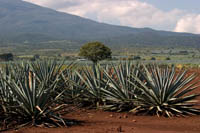 Coming from Guadalajara you drive through miles of the spiky blue-green agave, which, despite rumors to the contrary, is not a cactus. This succulent is part of the lily family which also includes its cousin, yucca. On an organized tour, your first stop is at one of these agave fields on the Cuervo plantation. If it’s wet, be sure to stick to the stone driveway or you’ll sink into the wet clay of the fields.
Coming from Guadalajara you drive through miles of the spiky blue-green agave, which, despite rumors to the contrary, is not a cactus. This succulent is part of the lily family which also includes its cousin, yucca. On an organized tour, your first stop is at one of these agave fields on the Cuervo plantation. If it’s wet, be sure to stick to the stone driveway or you’ll sink into the wet clay of the fields.
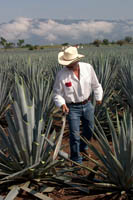 Here, we learn that an agave plant takes eight to twelve years to mature enough for harvesting and can grow to 12 or 14 feet in diameter. A jimador (agave harvester) demonstrates how the spikes are cut off the leaves of the agave with a machete to make them less sharp to work with; to force the nutrients to the heart of the agave, making it grow larger; and to prevent butterflies from nesting in the tips. The butterfly larvae or worms that are sometimes found in a bottle of mezcal, are never found in tequila. “If it is tequila” says Guillermo, our English-speaking guide, “there is no worm.” If left to grow wild, the agave would sprout a tall flower in the center, but these are also cut off to make the heart grow larger and sweeter.
Here, we learn that an agave plant takes eight to twelve years to mature enough for harvesting and can grow to 12 or 14 feet in diameter. A jimador (agave harvester) demonstrates how the spikes are cut off the leaves of the agave with a machete to make them less sharp to work with; to force the nutrients to the heart of the agave, making it grow larger; and to prevent butterflies from nesting in the tips. The butterfly larvae or worms that are sometimes found in a bottle of mezcal, are never found in tequila. “If it is tequila” says Guillermo, our English-speaking guide, “there is no worm.” If left to grow wild, the agave would sprout a tall flower in the center, but these are also cut off to make the heart grow larger and sweeter.
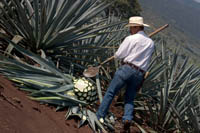 The jimador demonstrates on another plant how the agave is harvested, using a flat blade tool called a coa to cut off the leaves exposing the heart of the agave or pińa (called pineapple for its shape). The pińas usually weigh anywhere from 80 to 200 pounds. A good jimador can harvest over a ton of pińas in a day. The pińas are loaded onto trucks and taken into town to the distillery. Our jimador slices one in half and cuts off slivers for us to taste. It reminds me of jicama, a texture similar to a potato, but sweeter.
The jimador demonstrates on another plant how the agave is harvested, using a flat blade tool called a coa to cut off the leaves exposing the heart of the agave or pińa (called pineapple for its shape). The pińas usually weigh anywhere from 80 to 200 pounds. A good jimador can harvest over a ton of pińas in a day. The pińas are loaded onto trucks and taken into town to the distillery. Our jimador slices one in half and cuts off slivers for us to taste. It reminds me of jicama, a texture similar to a potato, but sweeter.
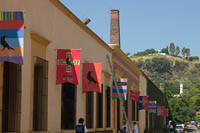 From the agave fields we continue into the town of Tequila, where the Cuervo factory, La Rojeńa, takes pride of place in the center of town, just off the plaza. The buildings of Mundo Cuervo actually fill two blocks on opposite sides of Calle José Cuervo. The Sauza Family Museum is on the other side of an adjoining wall and the National Tequila Museum is across Calle Ramon Corona. Street names change almost every block.
From the agave fields we continue into the town of Tequila, where the Cuervo factory, La Rojeńa, takes pride of place in the center of town, just off the plaza. The buildings of Mundo Cuervo actually fill two blocks on opposite sides of Calle José Cuervo. The Sauza Family Museum is on the other side of an adjoining wall and the National Tequila Museum is across Calle Ramon Corona. Street names change almost every block.
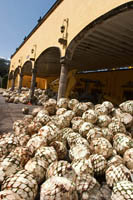 The main entrance to Mundo Cuervo is through an archway on the left side of Calle José Cuervo, across the street from Mundo Cuervo’s Cholula restaurant. The courtyard entrance to the factory is filled with a giant sculpture of a bird, representing the Cuervo crow, an oft repeated theme throughout Mundo Cuervo. Its live counterpart has pride of place in a cage in an inner courtyard. The Cuervo tour is an indoor-outdoor experience, but if it’s raining, they have enough umbrellas for everyone.
The main entrance to Mundo Cuervo is through an archway on the left side of Calle José Cuervo, across the street from Mundo Cuervo’s Cholula restaurant. The courtyard entrance to the factory is filled with a giant sculpture of a bird, representing the Cuervo crow, an oft repeated theme throughout Mundo Cuervo. Its live counterpart has pride of place in a cage in an inner courtyard. The Cuervo tour is an indoor-outdoor experience, but if it’s raining, they have enough umbrellas for everyone.
Tours begin with an orientation video in Spanish with English subtitles that introduces you to the history of Casa José Cuervo and the process of growing blue agave and turning it into fine tequilas. Then we follow our guide into the factory area where pińas are piled high waiting to be split and shoveled into room-sized steam ovens.
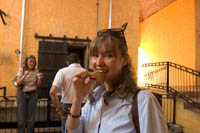 The pińas cook in the steam ovens for 36 hours to convert the starches to sugar. We get to taste a slice of the cooked agave. Although the sign says it tastes like yam, I find it much sweeter, almost like raw sugar cane, but with a tequila aftertaste.
The pińas cook in the steam ovens for 36 hours to convert the starches to sugar. We get to taste a slice of the cooked agave. Although the sign says it tastes like yam, I find it much sweeter, almost like raw sugar cane, but with a tequila aftertaste.
After cooking, the clumps of agave are allowed to cool for eight hours before being hand loaded onto conveyor belts that take them into the mill. Four mills tear up the pińas, grind them and press out the liquid. The liquid from the milled agave, called mosto or “must” is gathered in stainless steel vats where yeast is added and it ferments for about 18 hours, transforming the sugars into alcohol.
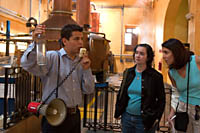 The brown fermented liquid is then distilled twice in copper stills resulting in a clear tequila that is about 55% alcohol. Since 40% is the maximum allowed, it has to be diluted with de-mineralized water to reduce the alcohol content. This fresh tequila,Tequila Blanco – also called plata or silver – is stored in stainless steel vats and bottled within 15 days.
The brown fermented liquid is then distilled twice in copper stills resulting in a clear tequila that is about 55% alcohol. Since 40% is the maximum allowed, it has to be diluted with de-mineralized water to reduce the alcohol content. This fresh tequila,Tequila Blanco – also called plata or silver – is stored in stainless steel vats and bottled within 15 days.
To mellow out the sharp taste, some of the tequila is aged in American or 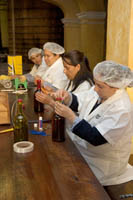 French oak barrels. Tequila aged from two months to a year is considered Tequila Reposado or rested. Aging in wood adds color as well as flavor to the tequila. Tequila aged a year or more is Tequila Ańejo. These are grades of tequila, not brands. The tour guide explains the differences between Cuervo’s various tequila brands.
French oak barrels. Tequila aged from two months to a year is considered Tequila Reposado or rested. Aging in wood adds color as well as flavor to the tequila. Tequila aged a year or more is Tequila Ańejo. These are grades of tequila, not brands. The tour guide explains the differences between Cuervo’s various tequila brands.
In the Reserva Museum, we watch a quintet of workers hand-bottling, labeling and packaging the most precious of Cuervo’s brands, Reserva de la Familia – in slow motion for our benefit. As the tour group passes, production speeds up considerably. Tourists who chose the basic or tasting tours receive a thimble full of Reserva to taste before moving on to the Margarita Bar. Those of us on the Reserva Cellar Tour continue down to the Cava or cellar, the warehouse of the original factory which is now used exclusively for aging the Ańejos three years or older used to blend each year’s Family Reserve.
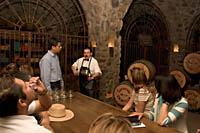 A tequillero extracts a measure of amber tequila directly from the barrel and pours it into a brandy snifter for each guest. Just like a wine tasting, we are instructed how to test the bouquet, the color and the body of the tequila before tasting it. This is definitely a sipping tequila, having many of the same properties as a good cognac or brandy.
A tequillero extracts a measure of amber tequila directly from the barrel and pours it into a brandy snifter for each guest. Just like a wine tasting, we are instructed how to test the bouquet, the color and the body of the tequila before tasting it. This is definitely a sipping tequila, having many of the same properties as a good cognac or brandy.
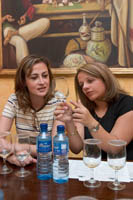 The problem with having the regular tequila testing after our visit to the Cellar is that nothing can compare with the Reserva we have just tasted. However, our palates are cleared a bit with the frozen margaritas that greet us in the courtyard of the Margarita Bar. Inside, the table is pre-set with three capped glasses of tequila at each place and a bilingual cheat sheet reviewing what to look for in a tasting. Interestingly, the three tequilas presented in the tasting are not even José Cuervo labels, they are a Blanco, a Reposado and an Ańejo that Cuervo produces under its Gran Centenario label.
The problem with having the regular tequila testing after our visit to the Cellar is that nothing can compare with the Reserva we have just tasted. However, our palates are cleared a bit with the frozen margaritas that greet us in the courtyard of the Margarita Bar. Inside, the table is pre-set with three capped glasses of tequila at each place and a bilingual cheat sheet reviewing what to look for in a tasting. Interestingly, the three tequilas presented in the tasting are not even José Cuervo labels, they are a Blanco, a Reposado and an Ańejo that Cuervo produces under its Gran Centenario label.
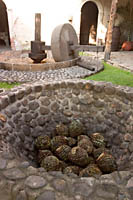 Off of the courtyard by the Margarita Bar is a gallery that wraps around to a gift shop selling fine art and hand crafts. Across the street, in an open courtyard, you can see part of the original distillery where the agave were roasted in underground pits and then milled with a grinding stone pulled by a mule. Another gift shop, where you can buy tequila and related products is in this courtyard.
Off of the courtyard by the Margarita Bar is a gallery that wraps around to a gift shop selling fine art and hand crafts. Across the street, in an open courtyard, you can see part of the original distillery where the agave were roasted in underground pits and then milled with a grinding stone pulled by a mule. Another gift shop, where you can buy tequila and related products is in this courtyard.
A little further down the street the Mundo Cuervo Museum houses exhibits of Mexican folk culture in the original hacienda. The Museum is sometimes closed for private meetings, conferences and events, so it is not always included in the tour. Public events are also held here. Mundo Cuervo has local Ballet Folklorico and pre-Hispanic dance groups and two Mariachi bands on staff. They are sometimes sent touring around the world to promote José Cuervo, but also participate in private functions at Mundo Cuervo and at local community events.
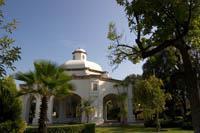 The gardens of the hacienda include a large gazebo often used for weddings and dances and a rodeo ring for charreria demonstrations. Through a fence, you can see the homestead where the family still stays when they are in town.
The gardens of the hacienda include a large gazebo often used for weddings and dances and a rodeo ring for charreria demonstrations. Through a fence, you can see the homestead where the family still stays when they are in town.
Mundo Cuervo has just added more conference and exhibition facilities on the other side of the street behind the factory. They are planning to use the stage area as a movie house for the local community when other activities are not scheduled.
Mundo Cuervo Tours are held on the hour Monday through Saturday 10 a.m. to 4 p.m., Sunday 11 a.m. to 1 p.m. I recommend calling ahead to arrange VIP tours and to make sure an English-speaking guide is available (not usually an issue, but it doesn’t hurt to make sure). Visit the web site www.mundocuervo.com or for information in Guadalajara, call (33) 3134-3368, or email: cuervo-tours@cuervo.com.mx . For information in Tequila, call (374) 742-2170 / 1168 or email:tours@cuervo.com.mx

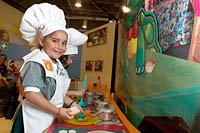 If you’re traveling with kids and they’ve had their fill of Guadalajara’s colonial history, head over to neighboring Zapopan to El Trompo Mágico, the Magic Top, for an indoor play day for the whole family. This interactive museum, which opened in 2003, has activities for kids of all ages. It’s not uncommon to see adults on their own or groups of seniors visiting Trompo Mágico as well.
If you’re traveling with kids and they’ve had their fill of Guadalajara’s colonial history, head over to neighboring Zapopan to El Trompo Mágico, the Magic Top, for an indoor play day for the whole family. This interactive museum, which opened in 2003, has activities for kids of all ages. It’s not uncommon to see adults on their own or groups of seniors visiting Trompo Mágico as well.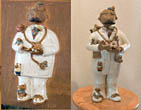 The Museum was designed as an educational enhancement to school curricula, but it won’t feel like school. The mission of Trompo Mágico is to develop a learning environment that will “uphold universal values while empowering people committed to a better world.” There are exhibits reflecting the themes of peace, diversity, equality and tolerance, but if you don’t speak Spanish you might mistake them for just more fun and eye candy.
The Museum was designed as an educational enhancement to school curricula, but it won’t feel like school. The mission of Trompo Mágico is to develop a learning environment that will “uphold universal values while empowering people committed to a better world.” There are exhibits reflecting the themes of peace, diversity, equality and tolerance, but if you don’t speak Spanish you might mistake them for just more fun and eye candy.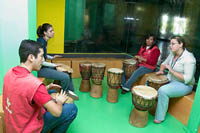 The museum is filled with helpful Nei’wáma (plural for Nei’wá, meaning friend, companion or guide in the Huichol language) to facilitate the learning experience. They can be identified by their brightly colored vests. Many of the Nei’wá are students from local colleges doing required community service hours.
The museum is filled with helpful Nei’wáma (plural for Nei’wá, meaning friend, companion or guide in the Huichol language) to facilitate the learning experience. They can be identified by their brightly colored vests. Many of the Nei’wá are students from local colleges doing required community service hours.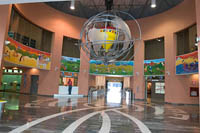 You enter the museum into a large lobby with a cutout globe around a yellow spinning top overhead. After buying your tickets, most of what you want to see and do is through the Voy Derecho (Straight Ahead) Hall of Children’s Rights, filled with touchable sculptures by local artist Rodolfo Padilla, and around the circular courtyard (or across if it’s not raining) to the Pabellón Mágico (Magic Pavilion).
You enter the museum into a large lobby with a cutout globe around a yellow spinning top overhead. After buying your tickets, most of what you want to see and do is through the Voy Derecho (Straight Ahead) Hall of Children’s Rights, filled with touchable sculptures by local artist Rodolfo Padilla, and around the circular courtyard (or across if it’s not raining) to the Pabellón Mágico (Magic Pavilion).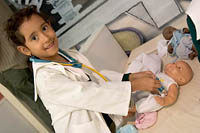 From the entrance of the Pabellón Mágico, to the far right is Maroma (Summersault), a children’s role play area. Here little ones can don the appropriate garb and get to work making tortillas and selling vegetables in a child-size market; creating and stamping letters at a mini post office; administering shots and listening for baby doll heartbeats at the hospital; cooking up and serving some yummy play food at the restaurant; or building something monumental at the construction site.
From the entrance of the Pabellón Mágico, to the far right is Maroma (Summersault), a children’s role play area. Here little ones can don the appropriate garb and get to work making tortillas and selling vegetables in a child-size market; creating and stamping letters at a mini post office; administering shots and listening for baby doll heartbeats at the hospital; cooking up and serving some yummy play food at the restaurant; or building something monumental at the construction site.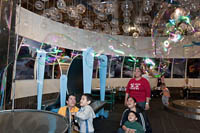 Behind Maroma to the left is Burbujas, the bubble area. I have seen a lot of cool bubble exhibits at science museums around the U.S., but this is by far the best I’ve come across. I am not quite sure how making giant soap bubbles teaches responsible consumption of water. The message gets lost in the fun of creating a giant string of bubble that stretches across the room; using teamwork to wrap a huge bubble from two long soapy poles; putting your soapy hand in and out of a sheet of bubble without breaking it, or, best of all, getting inside a massive tube of bubble.
Behind Maroma to the left is Burbujas, the bubble area. I have seen a lot of cool bubble exhibits at science museums around the U.S., but this is by far the best I’ve come across. I am not quite sure how making giant soap bubbles teaches responsible consumption of water. The message gets lost in the fun of creating a giant string of bubble that stretches across the room; using teamwork to wrap a huge bubble from two long soapy poles; putting your soapy hand in and out of a sheet of bubble without breaking it, or, best of all, getting inside a massive tube of bubble.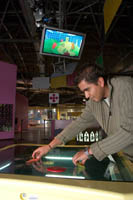 In the Garabato (Scribble) exhibit, you might expect something to do with painting, or drawing, but in reality, you’ll find a variety of high tech exhibits on modern cultural expression demonstrating how art and science come together in daily life. On the low tech end, you can join in a drum circle with traditional Brazilian drums. If you want to go more high tech, you can sit in on a jam session with electronic musical instruments. Children and adults can learn how a radio station broadcasts; create your own film and learn to edit it; experiment with four different ways of creating animated films; try your hand at digital photography; and learn how a newspaper is put together.
In the Garabato (Scribble) exhibit, you might expect something to do with painting, or drawing, but in reality, you’ll find a variety of high tech exhibits on modern cultural expression demonstrating how art and science come together in daily life. On the low tech end, you can join in a drum circle with traditional Brazilian drums. If you want to go more high tech, you can sit in on a jam session with electronic musical instruments. Children and adults can learn how a radio station broadcasts; create your own film and learn to edit it; experiment with four different ways of creating animated films; try your hand at digital photography; and learn how a newspaper is put together.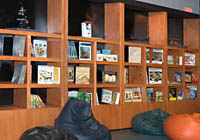 biodiversity of the planet. Learn how a tornado is formed or take a virtual reality submarine tour. The final area, Eureka, has hands-on and interactive computer exhibits allowing you to operate robots, take trip into space and explore telecommunications possibilities. This area also includes the IBM Try Science exhibit, a computer game that gives you points for learning the science behind the action.
biodiversity of the planet. Learn how a tornado is formed or take a virtual reality submarine tour. The final area, Eureka, has hands-on and interactive computer exhibits allowing you to operate robots, take trip into space and explore telecommunications possibilities. This area also includes the IBM Try Science exhibit, a computer game that gives you points for learning the science behind the action.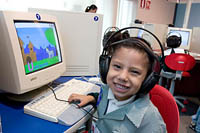 The Mediateca(Computer Room) offers dozens of computer terminals with fun and educational programs for all ages designed by the in-house educational media team. Off the main lobby is the Museum store and the temporary exhibit hall with rotating exhibits. Through February 2006, an exhibit on Charreria, Mexico’s cowboy and rodeo tradition, includes regularly scheduled
The Mediateca(Computer Room) offers dozens of computer terminals with fun and educational programs for all ages designed by the in-house educational media team. Off the main lobby is the Museum store and the temporary exhibit hall with rotating exhibits. Through February 2006, an exhibit on Charreria, Mexico’s cowboy and rodeo tradition, includes regularly scheduled 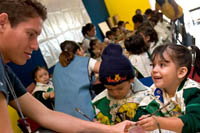 roping demonstrations. At the other end of the building, three workshops provide hands-on arts and science projects for children, teens and parents. Upstairs, a gallery between the administrative offices and the circular conference room hosts art exhibits.
roping demonstrations. At the other end of the building, three workshops provide hands-on arts and science projects for children, teens and parents. Upstairs, a gallery between the administrative offices and the circular conference room hosts art exhibits.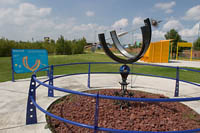 explore. Three playgrounds with age-appropriate equipment for pre-school, elementary and secondary students are near the cafeteria. On the opposite side, the Peace Labrynth is a circular maze where various activities are held promoting non-violent conflict resolution. Beyond that, on weekends and holidays you’ll find Voy que Vuelo (I can fly), which includes a sky diving simulator and canopy ride (additional fee).
explore. Three playgrounds with age-appropriate equipment for pre-school, elementary and secondary students are near the cafeteria. On the opposite side, the Peace Labrynth is a circular maze where various activities are held promoting non-violent conflict resolution. Beyond that, on weekends and holidays you’ll find Voy que Vuelo (I can fly), which includes a sky diving simulator and canopy ride (additional fee).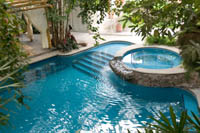 The only spa of its kind in the Guadalajara area, Piedra Viva’s non-prepossessing grey exterior shelters an oasis of tranquility. Zen inspired treatment rooms on two levels open onto a glass-enclosed greenery-filled atrium sheltering an aqua blue pool with several gentle waterfalls. You can enjoy this tropical outdoor garden pool even in the pouring rain. In a separate, open courtyard is the Temazcal or traditional adobe sweat lodge.
The only spa of its kind in the Guadalajara area, Piedra Viva’s non-prepossessing grey exterior shelters an oasis of tranquility. Zen inspired treatment rooms on two levels open onto a glass-enclosed greenery-filled atrium sheltering an aqua blue pool with several gentle waterfalls. You can enjoy this tropical outdoor garden pool even in the pouring rain. In a separate, open courtyard is the Temazcal or traditional adobe sweat lodge.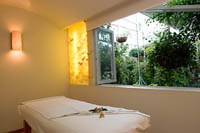 Piedra Viva offers an extensive menu of massage techniques from around the world, hydrotherapies, aromatherapies, vinotherapy (wine based treatments), body wraps of mud, algae or chocolate (to name just a few), exfoliations, facials, manicures and pedicures. The Jacuzzi, sauna, steam bath and pool are also available to clients before and after treatments. An on site restaurant offers a light menu to keep you going between treatments. Salads, sandwiches and omelets are the featured fare.
Piedra Viva offers an extensive menu of massage techniques from around the world, hydrotherapies, aromatherapies, vinotherapy (wine based treatments), body wraps of mud, algae or chocolate (to name just a few), exfoliations, facials, manicures and pedicures. The Jacuzzi, sauna, steam bath and pool are also available to clients before and after treatments. An on site restaurant offers a light menu to keep you going between treatments. Salads, sandwiches and omelets are the featured fare.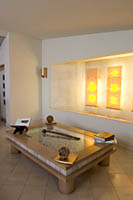 The Spa manager, Alejandra Padilla, speaks fluent English. The receptionist also speaks enough English to schedule your appointment, but if you need to discuss all your options and get recommendations, ask for Alejandra. The concierge at Quinta Real (or most other hotels) will be happy to make the call for you. If the hotel does arrange the treatment for you, they can also arrange for the Spa to cover your taxi.
The Spa manager, Alejandra Padilla, speaks fluent English. The receptionist also speaks enough English to schedule your appointment, but if you need to discuss all your options and get recommendations, ask for Alejandra. The concierge at Quinta Real (or most other hotels) will be happy to make the call for you. If the hotel does arrange the treatment for you, they can also arrange for the Spa to cover your taxi.